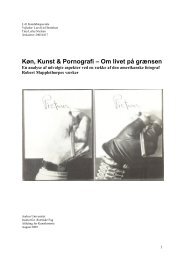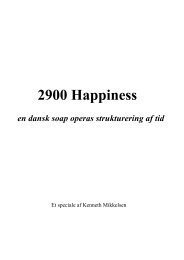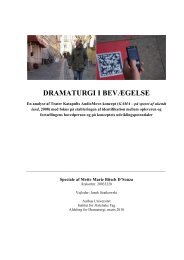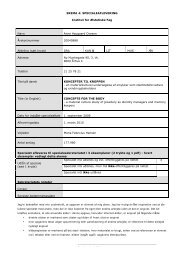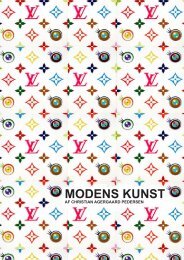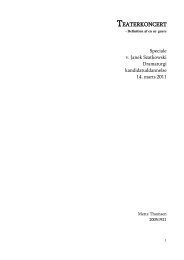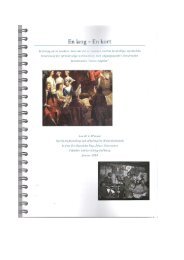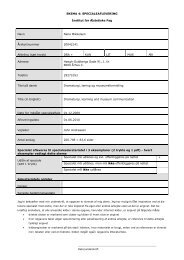Afdeling for Æstetik og Kultur — Tværæstetiske Studier - AU Library ...
Afdeling for Æstetik og Kultur — Tværæstetiske Studier - AU Library ...
Afdeling for Æstetik og Kultur — Tværæstetiske Studier - AU Library ...
You also want an ePaper? Increase the reach of your titles
YUMPU automatically turns print PDFs into web optimized ePapers that Google loves.
Speciale af Helle Børsen Rosholm Vejleder Hans Jørgen Frederiksen<br />
Årskortnummer 20032411<br />
English summary<br />
In the last three decades of the 19. century, various ideas from psychol<strong>og</strong>y, philosophy and<br />
religious trends merged with other currents to feed broad-based dissatisfaction, with the values<br />
inherent in biol<strong>og</strong>ical and evolutionary ideas of human achivement, and specifically with the<br />
dominant ideals of elaborate mimesis in art. A key to pr<strong>og</strong>ress in the artistic field of thought<br />
in<br />
the 1880s and 1890s was a revival of an Enlightment view of the mind, separate from<br />
biol<strong>og</strong>ical and historical considerations. This was the intellectual environment <strong>for</strong> Gauguins<br />
carreer as an artist. In creating new works of art, Gauguin drew from countless sources of<br />
inspiration in an eclectic and subjective manner. He combined his impressions and ideas<br />
with<br />
his fellow artist’s imageries and notions into astonishing painted collages. The metaphorical,<br />
expanded use of the term ”collage” developed by arthistorian Camilla Paldam is inspired<br />
by a<br />
pragmatic<br />
notion of the collage in which the collage is defined by structure rather than<br />
technique: elements that are in the wrong place, in the wrong context in surprising<br />
constellations. The collage consists of juxtaposed elements, elements that we as viewers<br />
combine into a unit. This mode of borrowing sources used <strong>for</strong> the first time in ”Nude study<br />
(Woman Sewing)” was to serve Gauguin throughout his life, and when Gauguin paid homage<br />
to the provincial art of Brittany, he took the most general stylistic encouragement from its<br />
rustic naiveté; and he mixed these admirations with a seemingly capricious attention to<br />
Oriental, South American, and early Western arts into an eclectic, ambigous and surprising<br />
unity.<br />
One of the philosphical trends that inspired Gauguin and his circle was the<br />
Neoplatonic way of thinking that offered a metaphysical security, an antidote to and escape<br />
from the relativity of everyday world. This philosophy made an attractive alternative to the<br />
widespread dissatisfaction with positivism. In this notion, the use of memory would help<br />
simplify the image, in fact necessitated the paring down to essentials and the exaggeration of<br />
certain aspects. Memory also had an epistemol<strong>og</strong>ical and ontol<strong>og</strong>ical prioriry given to it by the<br />
Neoplatonic tradition wherein the soul had the ability to rec<strong>og</strong>nize Truth because it had<br />
prenatal aquaintance with the Forms or Ideas. The turn inwards to paint from memory offered<br />
Gauguin a way of using all his sources of inspiration freely and eclectic.<br />
89





